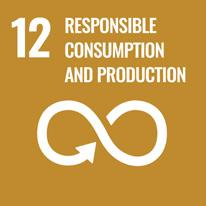Sustainability Report
Environmental, Social and Governance









In the last years, ENERGUATE has embraced a strong commitment to sustainable development and value creation for our employees, investors, suppliers, and communities, which is reflected in the 2024 Sustainability Report you now hold in your hands.

With this approach, we have come to understand that bringing electricity to communities is not just about connecting cables, it is about working with innovation and responsibility toward the environment, it is understanding that electric power can be a driver of transformation. We have made our own the challenge of contributing to the development of more than 13 million Guatemalans living within ENERGUATE´S concession area.
We firmly believe that environmental, social, and governance (ESG) efforts must be fully integrated and measurable in order to ensure real and sustained progress. In this regard, we work with the Sustainability Accounting Standards Board (SASB) to strengthen transparency and our performance measurement, while reaffirming our commitment to emissions reduction through the Science Based Targets initiative (SBTi). Additionally, we continuously assess the impacts of climate change on our operations to make strategic decisions that allow us to continue advancing on the path toward sustainability.
In 2024, we invested USD 1.9 million in community initiatives, positively impacting more than 500,000 people through reforestation projects, technology access programs, and efforts to connect more Guatemalans to the distribution network.
We have strengthened our occupational health and safety programs and workplace accident prevention efforts, maintaining our position for the fourth consecutive year among the leading companies in reducing lost-time injuries and total recordable incidents, in accordance with U.S. Department of Labor standards. We remain firmly committed to preventing fatal incidents by improving risk management and reinforcing oversight o our contractors, with the goal of achieving zero fatalities in 2025. Additionally, we reaffirm our preventive culture through the renewal of the ISO 45001:2018 certification, ensuring safer working environments for both employees and contractors.
Each year, we Connect more than 100,000 new homes and businesses to our network, and in 2024, we connected our 2.5 millionth customer. For this year, we have strong growth expectations, of increased energy demand in our market and of a substantial improvement in our quality indicators.
We extend our gratitude to everyone who is part of this journey: employees, contractors, communities, and investors. Together, we will continue building a more sustainable and prosperous future for Guatemala, always with the conviction that our work makes lasting impact on people’s lives by Creating Connections that Transform Lives.
Paulo César Parra GENERAL MANAGER ENERGUATE
At ENERGUATE, we promote sustainable development through innovative solutions that support the efforts of communities, businesses, and cities across the country. Our mission is not only to deliver energy, but also to transform lives, creating value through responsible actions and programs that connect millions of Guatemalans to a brighter future.
In 2024, we brought our energy to more than 2.5 million homes, businesses, companies, and institutions across 298 municipalities in 21 of Guatemala’s 22 departments. We ensure quality service by optimizing every component of the electricity chain.
2.5
MILLION CUSTOMERS
298
Together with our transmission company, RECSA, we strengthen the transport and transformation of energy to provide a stable and reliable supply.
As part of this commitment, we integrate responsible and sustainable practices into our operations. This not only benefits our customers but also ensures a positive impact on the environment, aligning us with ESG standards that promote inclusive and long-lasting development.
21 de 22
MUNICIPALITIES DEPARTMENTS
Note: another electricity distribution company.
The proactive management of risks and opportunities in the areas of ESG (Environmental, Social, and Governance) is the foundation of our daily actions and decisions, ensuring the long-term sustainability and positive impact of our operations.
This comprehensive approach allows us to achieve a balance between economic, social, environmental, and governance aspects. To reinforce our commitment to sustainability, we have adopted the international SASB (Sustainability Accounting Standards Board) standard.
This framework helps us measure, manage, and communicate our ESG performance, ensuring responsible and transparent management.
In ENERGUATE, we understand that the sustainability or our business depends on our ability to manage risks and seize market opportunities. This commitment is a core part of our strategy to ensure responsible and lasting growth.
It includes all our actions focused on distributing energy in an environmentally responsible manner.
It involves all the established policies, guidelines, and daily decisions we make as leaders in the energy sector.
Business Model and Innovation
It includes all initiatives focused on operational excellence.
It includes all our actions focused on distributing energy in a socially responsible manner.
It considers all our efforts to ensure the safety, wellbeing, and development of our people, because we create connections that transform lives.
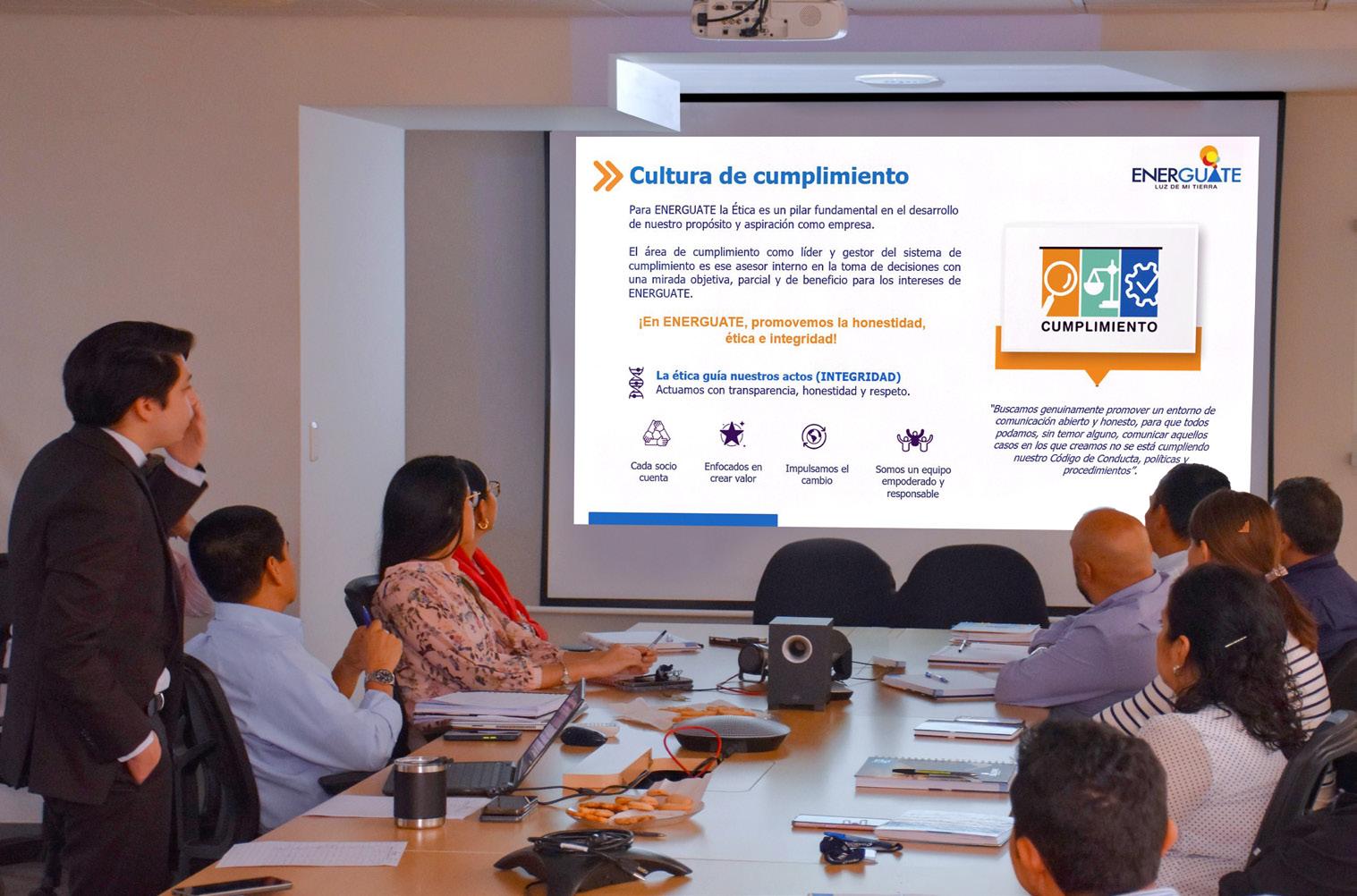
We are committed to the growth and development of all our stakeholders, as we adhere to high ethical standards. For ENERGUATE, integrity is a fundamental pillar in fulfilling the purpose of “Creating connections that transform lives”. Everyone who is part of this organization has the conviction to act with integrity and transparency, defining integrity through the following statements: “We are honest, transparent, and respectful. Inside and outside the company, we remain true to what we believe. We are kind, and our talents are at the service of others. Being part of ENERGUATE is a way of life.”
In an increasingly competitive business environment, risk management is crucial to ensuring sustainability of the business. At ENERGUATE, we adopt good corporate governance practices that establish and comply with guidelines and standards that govern our actions, contributing to the creation of business value.
Our prevention mechanisms mitigate risks to which the company may be exposed, in order to prevent irregular practices, fraud, and corruption, to achieve business sustainability, safeguard the company’s interests and preserve the integrity of our employees.
Our Code of Ethics and Conduct, along with our compliance policies, are the behavioral reference framework which establishes the expected standards of organizational integrity for all our stakeholders.
The Code of Ethics and Conduct and the Compliance Policies are mandatory tools for everyone who is part of ENERGUATE. They constitute an essential regulation for our daily activities, designed to reduce or mitigate various risks within our organization.
Third parties engaging with ENERGUATE as contractual business partners are committed to comply with the company’s regulations and the Supplier Code of Conduct, in addition to their legal obligation to act in accordance with the applicable law. The whole regulation is public and available to all employees through the company’s Intranet and to external stakeholders through ENERGUATE’s website.
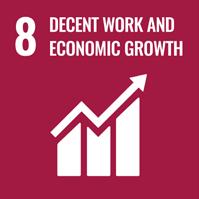
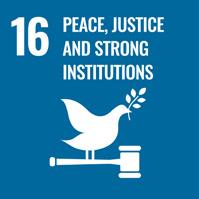

WE FIRMLY BELIEVE IN BUILDING BUSINESSES BASED ON ETHICAL AND RESPONSIBILITY PRINCIPLES IN ALL AREAS”.
Our Codes:
• Code of Ethics and Conduct.
• Supplier Code of Conduct.
Our Compliance Policies:
• Human Rights Policies.
• Anti-Corruption and Anti-Bribery Policy.
• Conflict of Interest Policy.
• Money Laundering and Terrorism Financing Policy.
• Gits and Business Courtesies Policy.
As an organization, we reaffirm our commitment to integrity, recognizing that each of us plays a fundamental role in this effort. This collective and individual commitment represents a significant achievement for the company, as it is built on the foundation of individuals and partners of integrity whose convictions align with our organizational objective, purpose, and mission.
Annual Commitment at Three Levels:
GENERAL MANAGER
PROCESS LEADERS
100%
INDIVIDUAL
99.3%
Commitment to the Employee Code of Ethics and Conduct. Adherence to the Supplier Code of Ethics and Conduct.
All ENERGUATE employees must be familiar with and comply with the Company’s Code of Ethics and Conduct, as well as the internal and external regulations applicable to our daily work.
In 2024, refresher training sessions were conducted for ENERGUATE employees, focusing on the content of the organization’s Code of Ethics and Conduct. These sessions were based on the development of corporate compliance governance and the complementary policies outlined in the Code.
To ensure that our employees have the proper knowledge and training, we have implemented:
– Mandatory onboarding process for new employees: The onboarding includes organization and structure, culture, operations, KPIs, internal regulations, and training on the ethics and compliance system.
– Annual compliance training program: As part of the compliance culture established within ENERGUATE, we strengthen our employees’ knowledge through training sessions.
– Ethics Capsules: In addition to training, we continuously share relevant communications and reference materials that help reinforce our understanding of corporate policies, procedures, and initiatives to strengthen our compliance culture.
100%
Newly hired personnel trained.
95%
5
Personnel with refresher training on the compliance system. Ethics capsules published throughout the year.
Through our reporting channel, we promote an opendoor policy that encourages employees to voice their concerns and reinforces their responsibility to report or disclose any known or suspected violations of the Code of Ethics and Conduct, internal regulations, or applicable law.
Reporting Channels Available:
At ENERGUATE, we have a Conflict of Interest Policy, which was updated in 2024. As part of our control policies, we have prevented, mitigated, and managed potential conflicts of interest through the disclosure and updating of information provided by our employees.
Compliance in the Conflict of Interest Disclosure Process:
How to Access:
Direct Ethics Line Portal: https://energuate.ethicspoint.com/
E-mail: cumplimiento@energuate.com Personal Interview.
Our Ethics Line is the communication channel available 24/7 to all employees and the general public. The process of investigating ethics reports is conducted with complete transparency, impartiality, and confidentiality, ensuring that no retaliation is taken against the whistleblower.
100%
Ethics reports are recorded, reviewed, and investigated.
56% 44%
Cases involving administrative actions. Dismissed cases. – Legal – Human Resources – General Management – Ethics Line – Compliance – Direct Supervisor
92.63% 7.63%
Current cases with no conflict of interest. Current cases related to conflict of interest.
Our Human Rights Policy promotes respect for and compliance with the United Nations (UN) Guiding Principles of “protect, respect, and remedy.”
We recognize that respecting Human Rights is a part of doing business with integrity and positions the company as a model of ethical conduct.
As part of the Due Diligence process, we assess if our suppliers have Human Rights policies and require them to adhere to ours in order to reaffirm our commitment.
We assess the risk profile of those we engage with, whether on an occasional or regular basis, in order to prevent and mitigate risks and identify opportunities for improvement through our Due Diligence processes.
We periodically review and update our records across the supply chain, commercial donation beneficiaries, Due Diligence guidelines, and release controls to ensure the implementation of key aspects.
processes, and/or best practices in occupational health and safety and environmental protection. Comply with the payment of local tax obligations and contributions.
Note: Human Rights supplier KPIs. Data obtained from the Compliance Desktop Third Party Due Diligence tool. January – December 2024. The indicators on equality, respect for gender diversity and non-discrimination, as well as those related to practices to prevent and mitigate forced and child labor, are aspects that have been fulfilled and are supported through commitment to and adherence to our Human Rights Policy.
We are aware that risk management is a crucial element for the sustainability of our business. That is why we have a Risk Management Policy, which guides the activities of the Corporate Risk Management Committee, responsible for overseeing and assessing the risks associated with our organization.
This policy establishes the foundations of a risk management culture based on a system of classification, weighting, levels, risk appetite, and tolerance. It enables the appropriate identification and prioritization of opportunities aimed at ensuring business continuity.
Throughout 2024, we focused our efforts on five key areas to strengthen security within the organization. These included the protection of critical infrastructure through remote access controls and secure architectures; proactive endpoint defense using systems capable of detecting and neutralizing threats in real time; and unified threat visibility through centralized monitoring platforms.
Additionally, we prioritized employee awareness through interactive programs that assessed and enhanced resilience against social engineering attacks, as well as the regulatory updating of internal policies to ensure alignment with global standards and compliance requirements.
1. Secure Access Controls: Implementation of robust VPN solutions with multi-factor authentication to ensure secure remote connections.
2. Perimeter and Cloud Protection: Deployment of next-generation firewalls for web applications and cloud services, along with strict network segmentation policies for public Ips.
3. Endpoint Defense: Evaluation and recommendations of advanced systems for automated threat detection and response on critical devices.
4. Centralized Monitoring: Implementation of a unified platform for log management and proactive incident detection.
5. Security Culture: Interactive campaigns (phishing simulations, educational bulletins, and specialized training) to strengthen employee awareness.
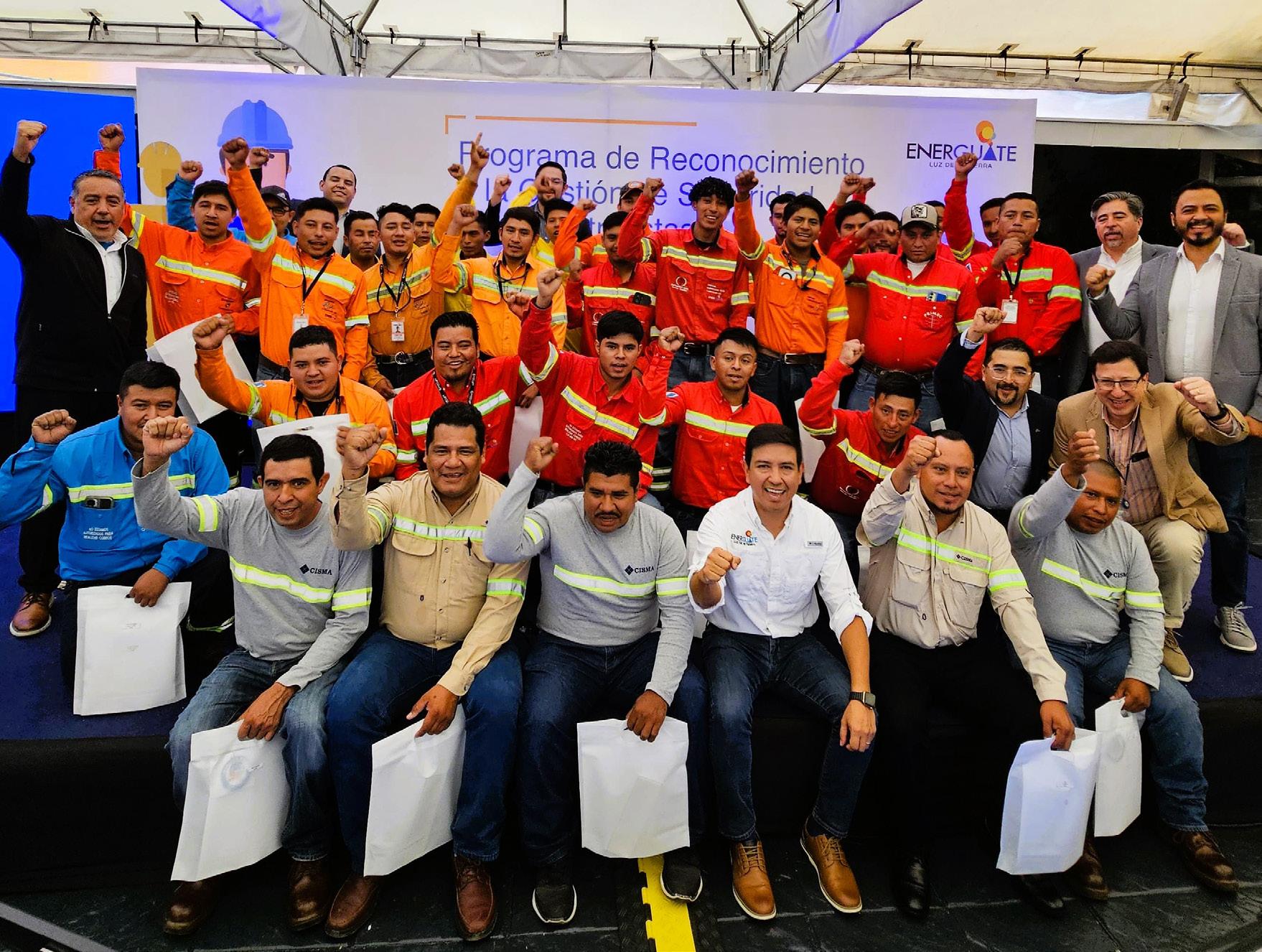
The safety of our employees is a priority that requires constant evaluation and improvement. With this guideline, we incorporated policies and protocols to make operations safer and work environments less risky. We also promote open and effective communication on prevention and protection matters, as well as recognition of safe work practices.
The success of this strategy also lies on the ongoing training of all employees. We offer specialized programs that not only teach them to identify risks and act preventively, but also prepare them to respond effectively in critical situations. This reinforces the collective commitment to safety at all levels of the organization.
To ensure the effectiveness of these efforts, we have strengthened the reporting process for accidents and near misses as a tool to help prevent future incidents.
This commitment to safety, protects our employees and contributes to the sustainability and long-term success of our operations.



The Critical Safety Task Program, highlights the importance of clearly understand the risks associated with critical activities as a key factor in keeping employees and contractors safe.
The Safety Is Everyone’s Job Program, reinforces that we all share the responsibility of complying with and ensuring adherence to policies, guidelines, and procedures.
The Safety Leaders Program, encourages the active participation of all employees and contractors by developing safety leadership skills.
The Near-Miss Program, focuses on the importance of ensuring that all near misses are reported, assessed, and investigated in a timely manner, and that corrective actions are implemented.
The Safety Management Recognition Program promotes and rewards best safety practices among both employees and contractors. ENERGUATE provides quarterly recognition to the safest brigades that meet the indicators of the Safety Plan and offers incentives to contractors who present innovation projects.
As a result of our prevention programs, our safety performance for both employees and contractors reflects a Lost Work Day Case Incident Rate (LWDCIR) of 0.15. The Total Recordable Cases Incident Rate (TRCIR) was 0.33. Historically, from 2018 to 2024, there has been a consistent downward trend in incidents, with performance remaining for four consecutive years better than the U.S. Department of Labor industry standard for these two indicators in the distribution business. Unfortunately, in 2024, a fatal incident occurred in one of the contracting companies performing tree-trimming activities for the company.
ENERGUATE’s Safety Performance in Distribution Incidents from Employees and Contractors
A total of 147 young individuals have successfully completed the training program “Low Voltage Line Electrician”, promoted by ENERGUATE in collaboration with the Technical Institute for Training and Productivity. This achievement, reached between 2023 and 2024, marks a significant step in strengthening the electrical industry and creating job opportunities in the country.
In addition to receiving high-quality technical training, the graduates gain access to ENERGUATE’s employment network and its contracting partners, ensuring decent working conditions and competitive salaries.
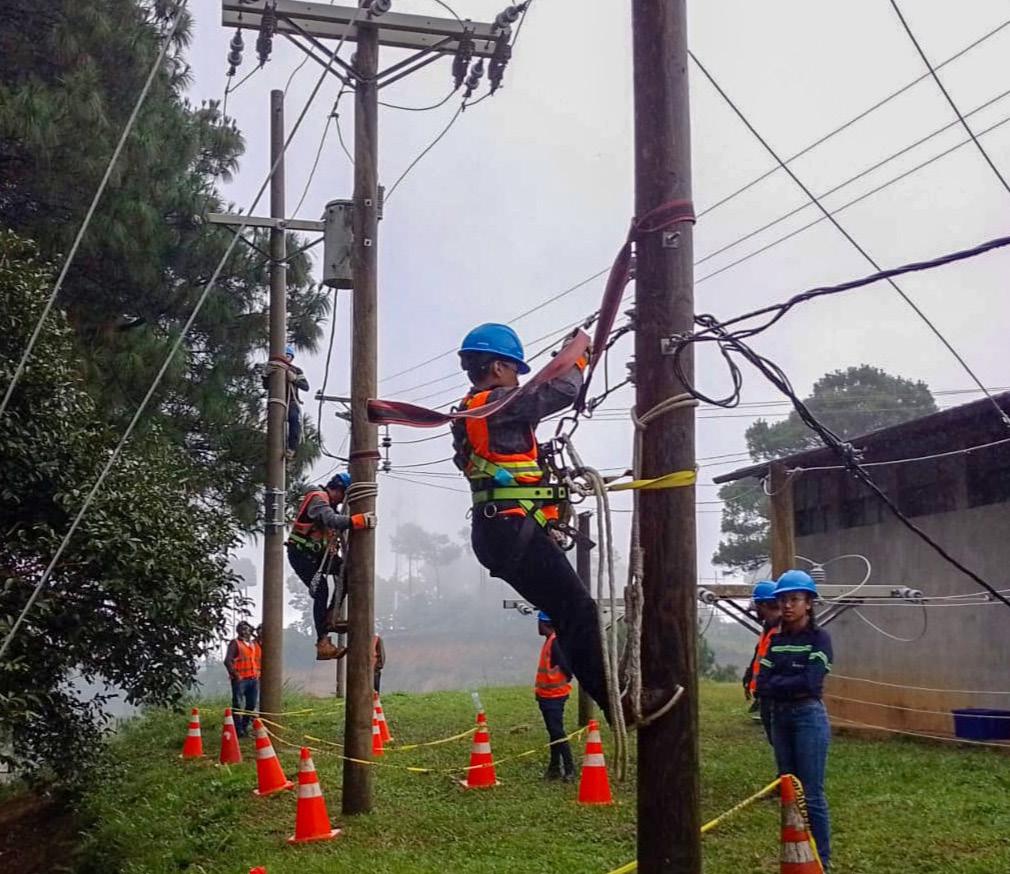
Note: Our safety performance remained above the U.S. Department of Labor’s industry standard in the distribution business for four consecutive years.
We are continuously strengthening our safety management to achieve zero fatalities annually, aiming to ensure a safe work environment where every employee and contractor performs their duties and returns home safely.
NOTHING IS MORE IMPORTANT THAN WORKING SAFELY AND THE COMMITMENT TO ENSURE THAT EVERY EMPLOYEE RETURNS HOME SAFE AND SOUND".
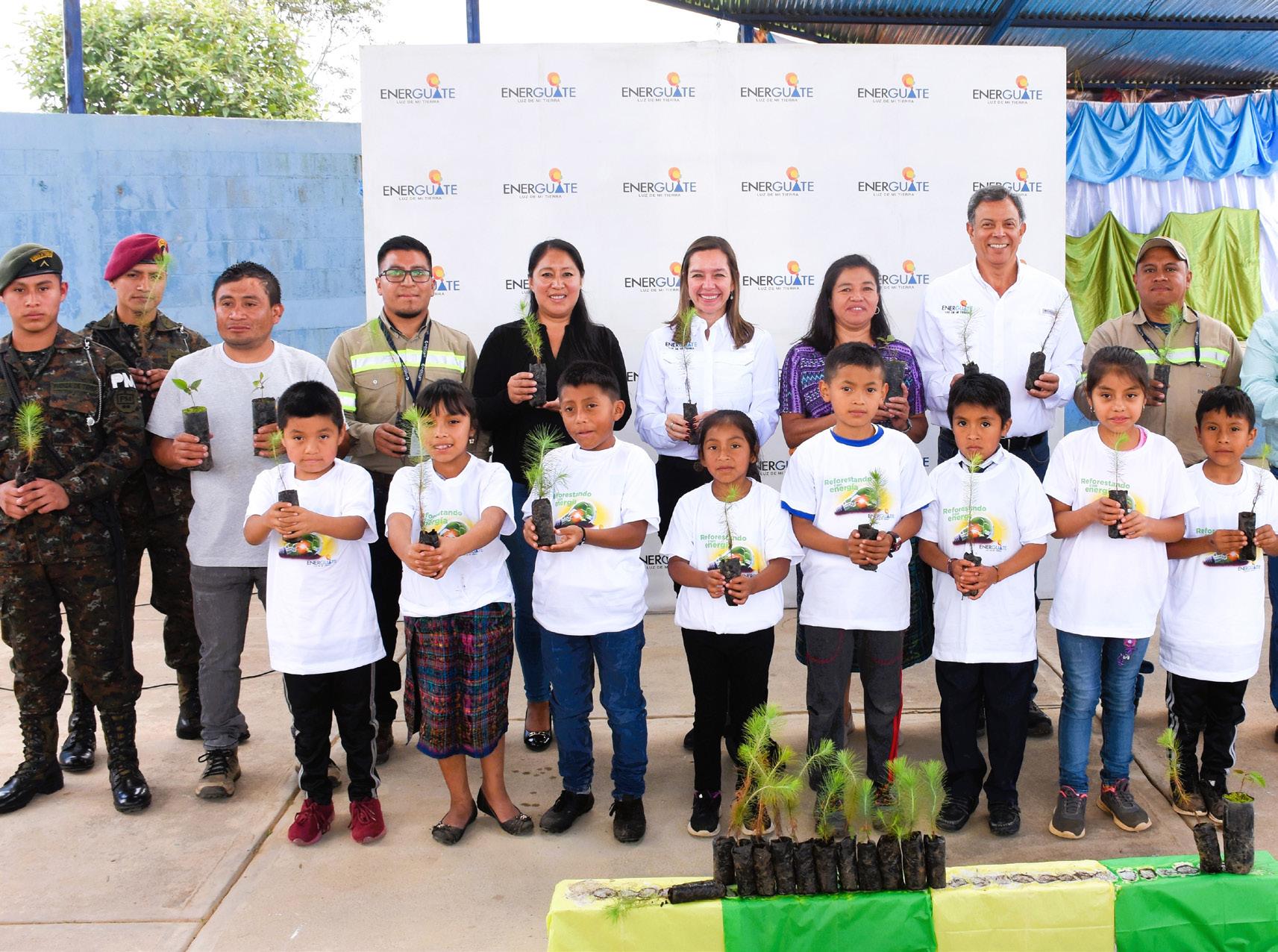
In ENERGUATE, our commitment to sustainability is demonstrated through clear objectives and concrete actions that reflect our Environmental Policy. Every initiative is aligned with our ESG Management System, ensuring a comprehensive approach to responsible development.
We actively work to meet and exceed environmental regulations, maintaining strict adherence to national provisions and international standards. This enables us to operate responsibly, minimizing impacts and promoting environmental preservation.
These actions strengthen our commitment to sustainability by promoting practices that not only ensure the viability or our operations but also support the well-being of communities and the conservation of natural resources for future generations.
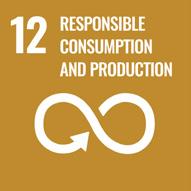
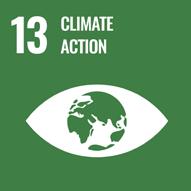

We promote the reduction of our water consumption through ongoing water conservation initiatives, minimizing waste and improving maintenance across our supply facilities.
Water Consumption (m3)
21,120 15,950 19,160 17,219 16,634
19,229 20,264
Note: In 2024, our target was exceeded due to additional water consumption required as a result of increased on-site presence of personnel at administrative offices across various regions of the country.
We optimize our internal energy consumption through energy efficiency initiatives, LED lighting, and staff awareness. Additionally, we set a reduction target that takes into account the forecasted increase in environmental temperatures.
Our active strategy to reduce air emissions in both the short and long term is based on minimizing losses in the network and optimizing fuel consumption in company vehicles through the Implementation of energy-saving initiatives. This approach is supported by accurate CO2 emissions measurement, enabling us to set targets and continuously improve over time, while working alongside customers and suppliers who support our efforts to reduce the carbon footprint of our operations.
In 2024, the management of non-hazardous waste successfully recycled 142 additional tons beyond the target, driven by an increase in operational activities. As for hazardous waste, we achieved effective management by generating amounts below the established target.
2,934 2,289 2,188 2,753 2,945 3,097 3,612
In 2024, our PCB elimination program within the distribution network identified only one transformer with more than 50 ppm among over 2,000 units removed, additionally, all transformers identified Between 2022 and 2024 were permanently disposed.
At ENERGUATE, we continuously assess our mediumand long-term environmental sustainability goals to define actions that also enable us to reduce CO2, emissions, water and energy consumption, and industrial waste.
WE VIEW SUSTAINABILITY AS A FUNDAMENTAL CONDITION FOR THE LONG-TERM VIABILITY OF OUR OPERATIONS”.
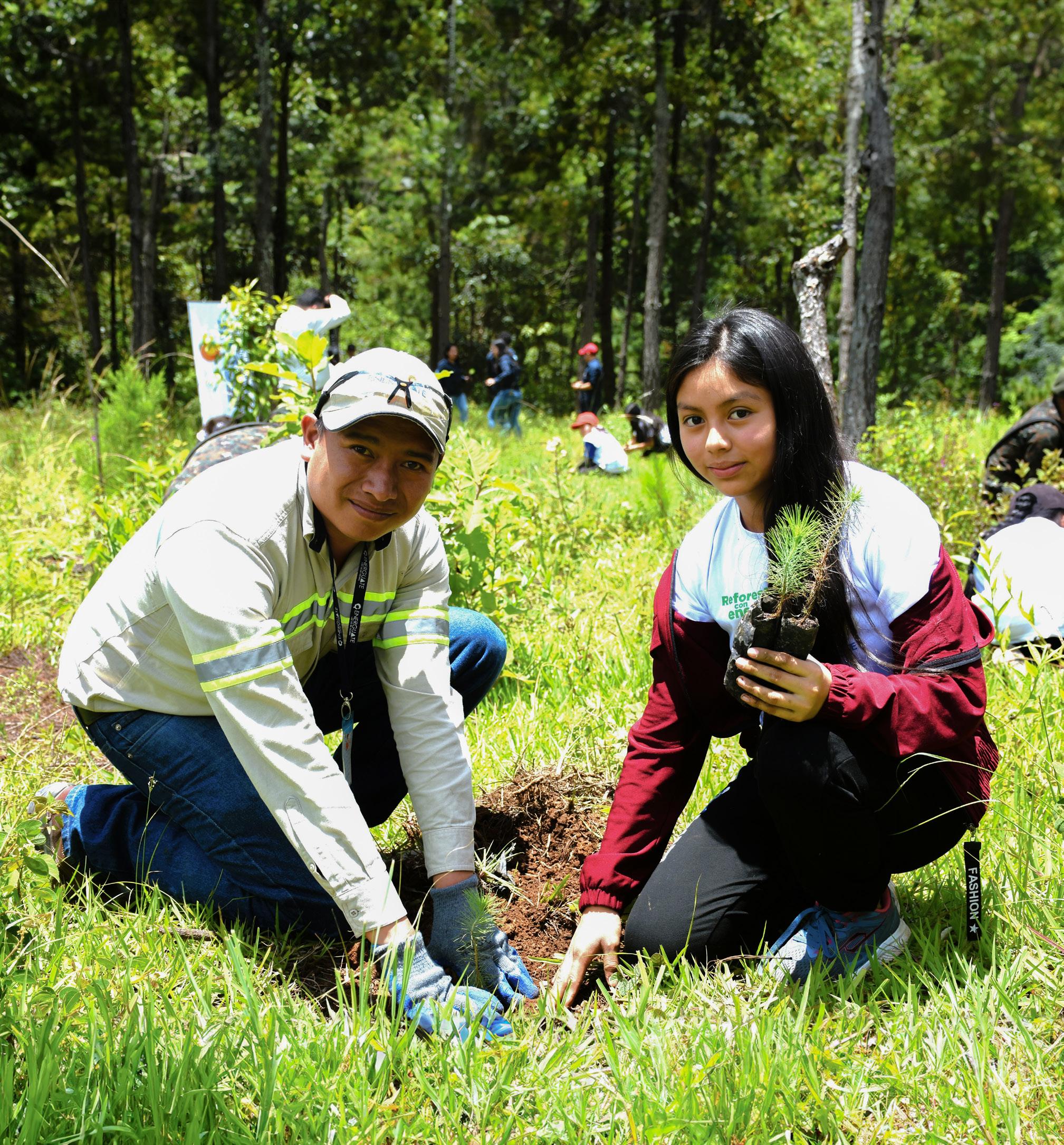
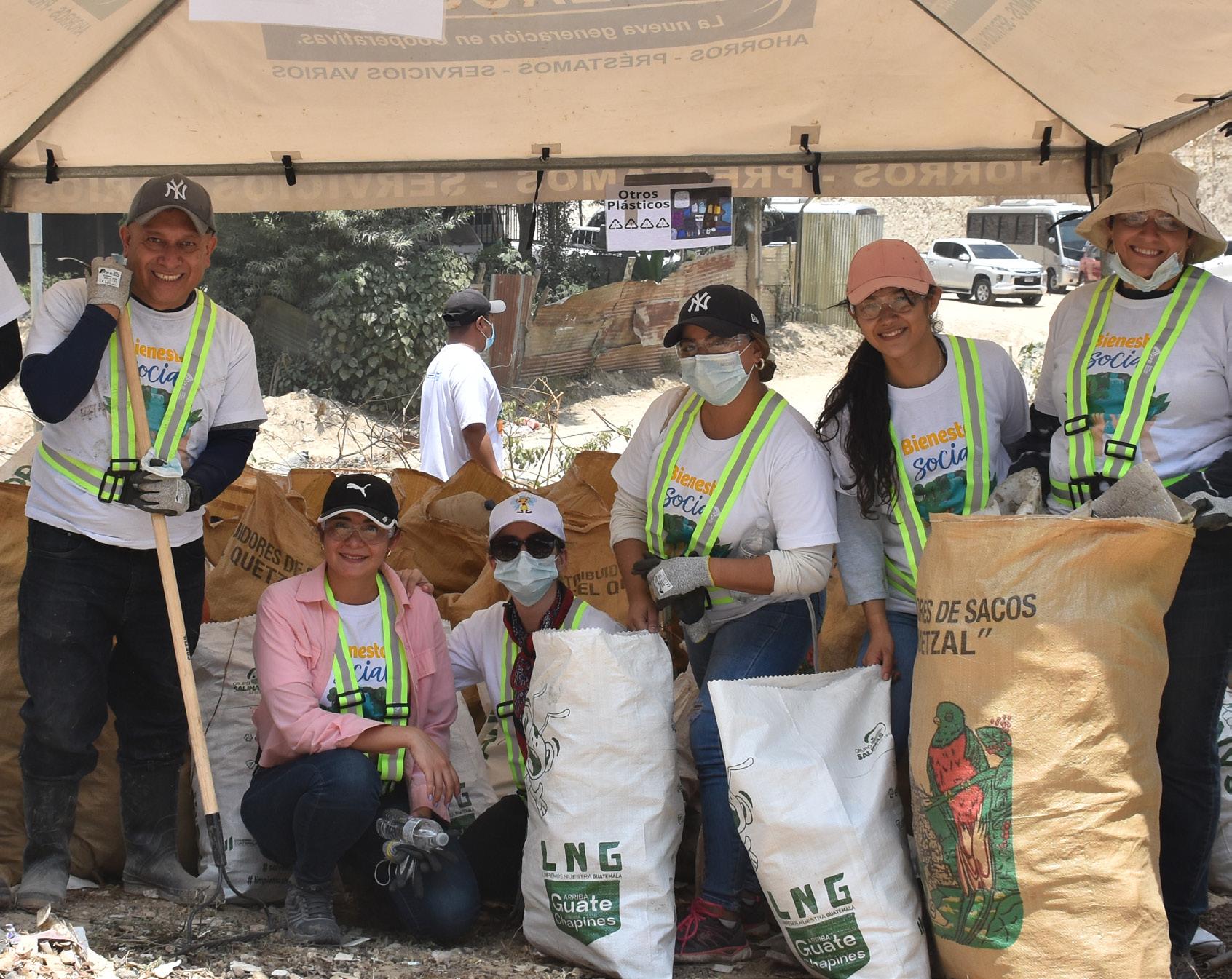
At ENERGUATE, we uphold an openness policy toward local communities, promoting active participation and dialogue as fundamental pillars of our operations. We establish open and transparent communication channels that allow us to listen to the concerns, needs, and proposals of the communities we engage with.
This approach not only builds trusting relationships but also ensures that our actions are aligned with local expectations and priorities, fostering harmonious and responsible coexistence.
This commitment reinforces our focus on inclusive and sustainable development, ensuring that the company’s growth and community well-being progress hand in hand.
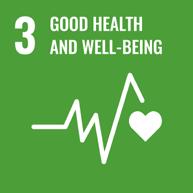
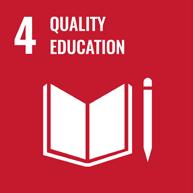
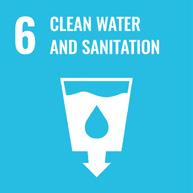
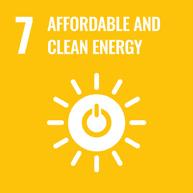
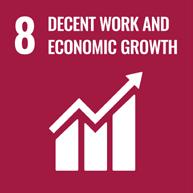


ENERGUATE’s policies are designed with a comprehensive approach that promotes human development as a key element for sustainable growth.
These policies prioritize inclusion, equity, and community well-being, ensuring that every initiative contributes positively to strengthening both individual and collective capacities.
The connection between our policies and the Human Development Goals is reflected in programs focused on education, decent employment, access to basic services, and environmental sustainability.
One of the core pillars of our social policy is technology. We have made the LucyMóvil – a bus equipped with computers and interactive content – available to student within our service area. In 2024 alone, it enabled over 38,000 children from rural areas of Guatemala to have their first experience with technology and the virtual world, while also providing guidance on electrical safety and the productive use of electricity.
As part of our customer outreach policy, three CineMóvil events were held in 2024 in El Estor, Izabal; Tiquisate, Escuintla; and El Asintal, Retalhuleu. During these events, community members enjoyed free familyfriendly movie screenings and took part in raffles and contests, strengthening our connection with customers and promoting recreational spaces.
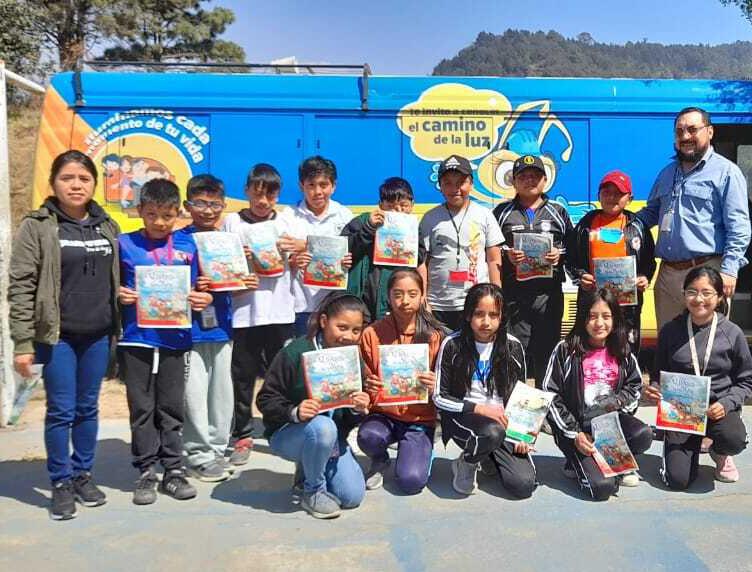
As a contribution to environmental conservation and to ensure quality service, three protected cable projects were carried out. These took place in Cuyotengo, Suchitepéquez (4 kilometers in length); El Semillero, Nueva Concepción, Escuintla (0.8 kilometers); and San Antonio, Suchitepéquez (1.2 kilometers). Through this innovation, families in these communities now benefit from a continuous and stable electricity supply, even during the rainy season. These efforts also help protect natural resources by avoiding three pruning and felling and preserving local ecosystems.
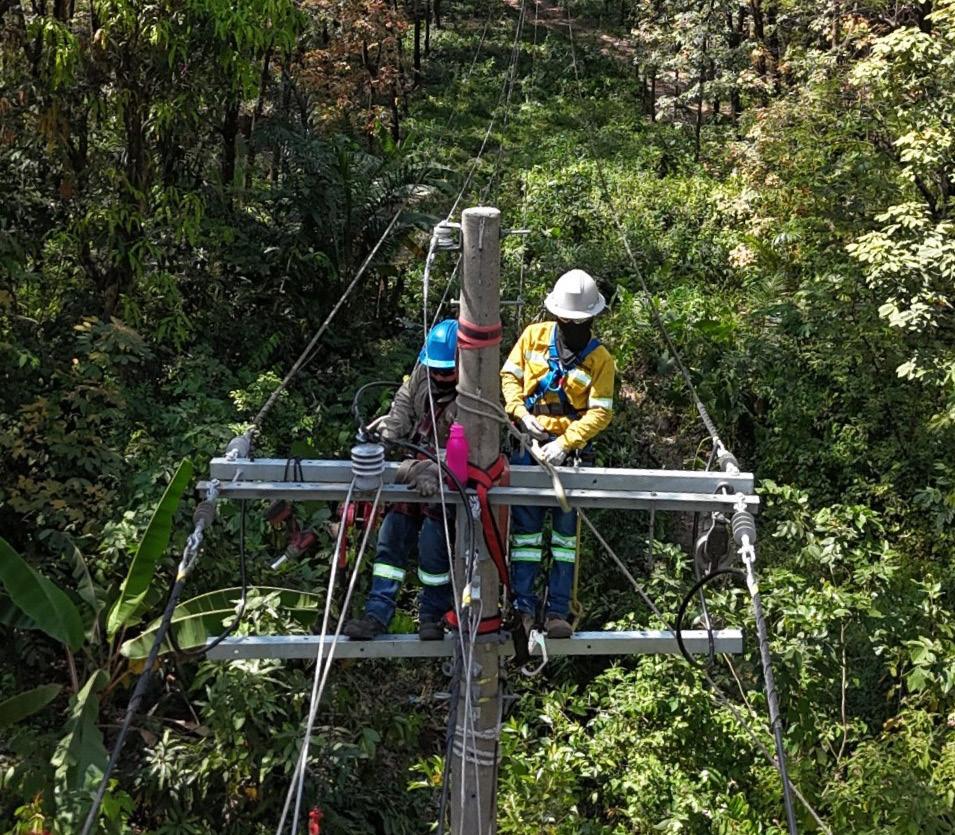
The energy efficiency efforts of the municipality of Tajumulco, San Marcos, were supported by assigning technical personnel to install 406 LED light bulbs of 40 watts each. This initiative helped reduce energy consumption for public lighting and improved street illumination conditions.
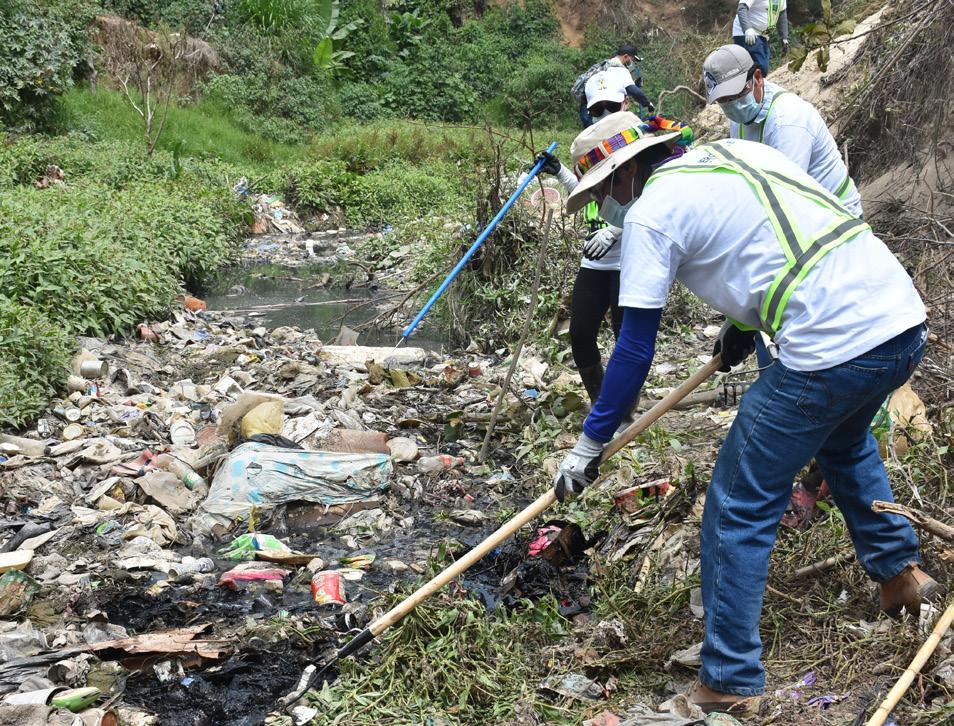
The distribution company maintains an ongoing community information and education program on energy efficiency, which enables communities to promote environmental protection. In addition, we have supported the efforts of municipalities, such as Nahualá, Sololá, in the proper disposal of discarded public lighting fixtures and the retrofitting of internal facilities for the handling of components removed from the distribution network.
Employees from the distribution companies joined Alianza Cuenca del Motagua, an initiative focused on one of the country’s most important yet highly polluted rivers, to carry out a cleanup in one of its most sensitive areas. During this activity, more than 16 tons of waste were collected.
As part of their program, “ENERGUATE verde”, the distribution companies launched a broad reforestation campaign, which resulted in the planting of over 52,000 saplings in priority areas for forest recovery. The initiative involved volunteers from companies, local authorities, and students.

In 2024, we completed the installation of electric service in 15 communities across four departments (Alta Verapaz, Baja Verapaz, Huehuetenango, and Quiché), connecting 2,039 families to the distribution network. This will provide them with greater well-being and opportunities for inclusive development.
The projects funded by ENERGUATE have transformed the lives of communities by providing lighting and energy for productive activities. These advancements improve residents' quality of life, drive local economic development, and facilitate access to education, healthcare, and technology. With each new project, the commitment to inclusion and sustainable progress in the country's most underserved areas is further strengthened.
ENERGUATE promotes a policy of openness and dialogue, with the support of government institutions, community organizations, and local leaders, aiming to reduce conflict.
The distribution company reaffirms its willingness to participate in dialogue tables to resolve current social conflicts fueled by opposing groups, some of which
operate outside the law, while others receive financial benefits by instigating illegal actions.
Through these processes, ENERGUATE has recovered areas that were taken over by disruptive groups. Upon resuming operations, the company facilitates the payment of overdue bills, promotes improvements to the network, and ensures the continuity of quality service.
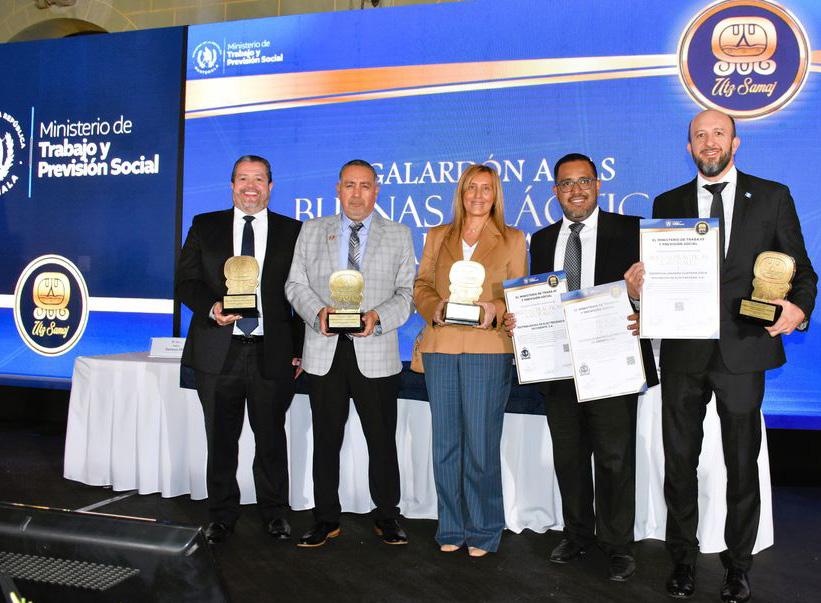
In ENERGUATE, labor relations with our employees are based on respect, equity, and holistic development. We foster an inclusive work environment that encourages open communication and active participation.
In addition, we ensure fair and dignified working conditions, along with opportunities for both professional and personal growth, as well as a healthy work-life balance.
This approach reflects our commitment to building strong and responsible labor rations, resulting in a positive impact for both our employees and the company’s overall performance.
Our organizational culture is the essence that strengthens and empowers us. Our core values, integrity, connection, problem-solving, excellence, and safety; guide our actions both within and beyond the company, as we strive to fulfill our purpose: “Create connections that transform lives.”
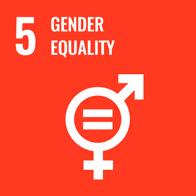
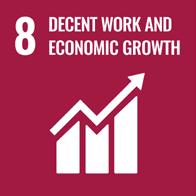
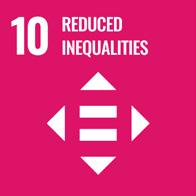

Our labor policies ensure dignified, fair, and inclusive working conditions, promoting the well-being and holistic development of our employees. They foster mutual respect, equity, and equal opportunities, while also guaranteeing compliance with labor rights such as health and safety.
– Recruitment and Selection Policy: Ensures a fair and transparent process to identify and retain employees with the necessary competencies to contribute to organizational success, selected through an efficient and transparent procedure.
– Compensation and Benefits Policy: Ensures competitive and fair working conditions, incentivizing performance and promoting employee satisfaction. By establishing clear benefits, the policy aims to strengthen team commitment and motivation.
– Diversity and Inclusion Policy: Contribuye Contributes to the creation of an inclusive work environment that values differences and ensures equal opportunities for everyone. This policy promotes a culture of respect and collaboration that enriches the organizational dynamic.
– Harassment-Free Workplace Policy: Ensures a safe and respectful work environment, free from any form of harassment or inappropriate behavior.
Establishes clear guidelines and tools to prevent and address any situation that may compromise the well-being of employees.
Work-Life Balance Policy: Promotes the overall well-being of employees by encouraging a healthy balance between work responsibilities and
–personal needs. Its goal is to enhance quality of life and strengthen productivity.
Training Policy: It is focused on promoting the professional and personal development of employees through ongoing training programs. By providing up-to-date tools and knowledge, this policy seeks to strengthen team competencies and ensure the shared growth of both the company and its employees.
As part of our efforts to develop our female talent, we continued with our Playing Big Program. This year, the women of ENERGUATE participated in storytelling workshop, where, through a creative methodology, they captured their personal journeys in written narratives.
The life stories came together to give rise to the book “Ocho Poderes”. Through this legacy, the company reaffirms its commitment to female empowerment.
1. Leadership development and self-confidence.
2. Opportunities to advance in their professional careers.
3. Access to key networking and mentorship.
4. Tools to overcome professional and personal challenges.
5. Empowerment to make effective strategic decisions.
In line with our efforts to promote gender equity and equality, we launched a training program for the prevention of gender-based violence. This program began with the training of trainers, who will, in turn, deliver the training to both employees and contractors throughout 2025.

In October 2024, the first external follow-up audit was conducted by AENOR to revalidate compliance with the requirements set by the ISO 45001:2018 standard. This audit process was crucial to verify that the company has maintained its health and safety standards, enabling it to continue improving and adapting to changes that may arise in the workplace and regulatory environment.
The external follow-up audit resulted in a favorable revalidation of the ISO 45001:2018 certification, confirming that ENERGUATE maintains a developing system focused on the effectiveness of occupational health and safety actions. AENOR highlighted the organization’s commitment to continuous improvement and the well-being of its employees, as well as ENERGUATE’s ability to effectively manage workplace risks and adapt to new challenges in the environment.
Occupational health and safety are key factors in ensuring employees’ quality of life, reducing workplace accidents and illnesses, and promoting a productive and healthy work environment.
Through this audit and revalidation process of its ISO 45001:2018 certification, ENERGUATE reaffirms its long-term vision, in which the well-being of people is a strategic priority.
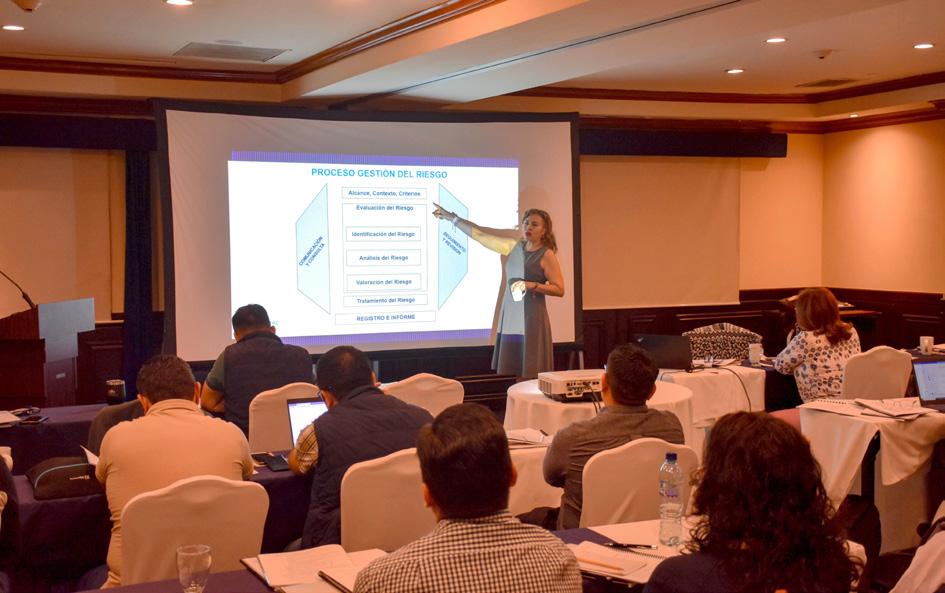
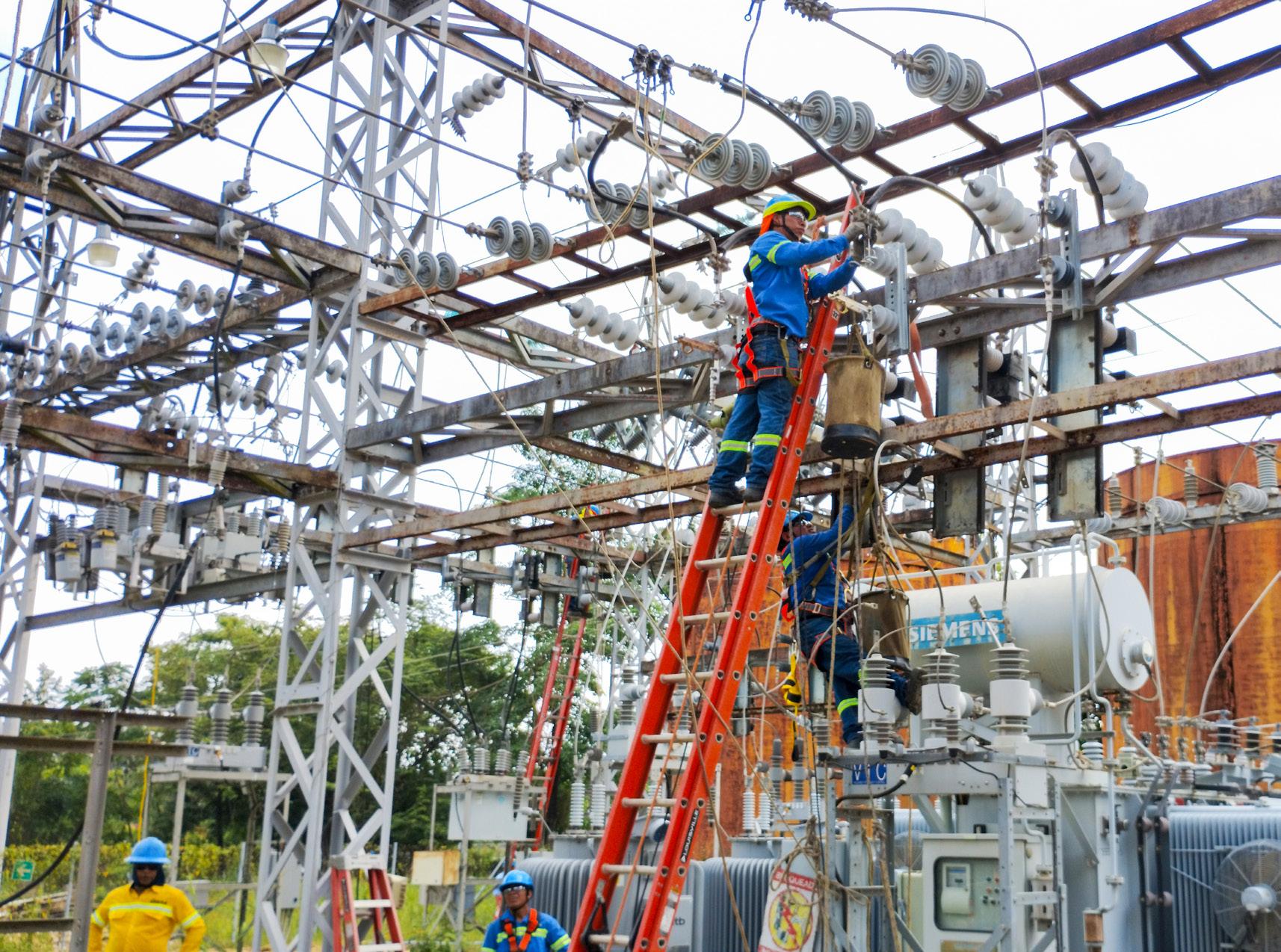
Operational excellence of ENERGUATE is reflected in its ongoing commitment to expanding the electrical grid, enabling access to more communities and improving existing infrastructure. These strategic investments ensure a reliable and stable power supply, contributing to the economic and social development of the regions served.
The connection of new customers is another key area, where efficiency and speed in processes are prioritized, promoting opportunities that enhance people’s quality of life and drive business growth.
ENERGUATE is also committed to incorporating technology and automating its operations, which optimizes internal processes and enhances service quality. These innovations enable quicker and more accurate responses to industry challenges, ensuring more agile and sustainable operations.
With advanced coordination systems and safety protocols, we ensure compliance with the highest industry standards while promoting the well-being and integrity of our employees and contractors.


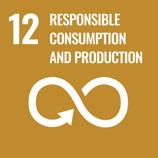

Note: DEOCSA and DEORSA were ranked eighth and ninth, respectively, among other distribution companies in the 2024 CNEE Customer Satisfaction Survey, placing four points above the average among the 19 distributors that participated in the survey.
Note: TTIK in Spanish stands for “Tiempo Total de Interrupción por KVA" (Total Interruption Time
In 2024, two new substations were put into operation: Todos Santos Cuchumatán in Huehuetenango and Tecún Umán in San Marcos. In the case of Todos Santos Cuchumatán, it is the first sub-transformation substation built in the department in the past 15 years. This facility improves service quality for 38,000 families and businesses in the central and northern areas of Huehuetenango.
The construction and energization of the Tecún Umán Substation in Ayutla, San Marcos, were also completed. This region comprises three municipalities with strong tourism, commercial, and industrial activity. A free trade zone has been established in the area, attracting foreign direct investment and generating employment opportunities for the local population through factories and industrial complexes.
1. Greater voltage stability, especially during peak consumption hours, minimizing disruptions for customers.
2. Increased customer connection capacity due to the available power from the new substations.
3. Network segmentation, reducing line lengths and allowing greater flexibility to shorten interruption times.
4. Capacity to interconnect new networks with other sources (substations), reducing outage durations.


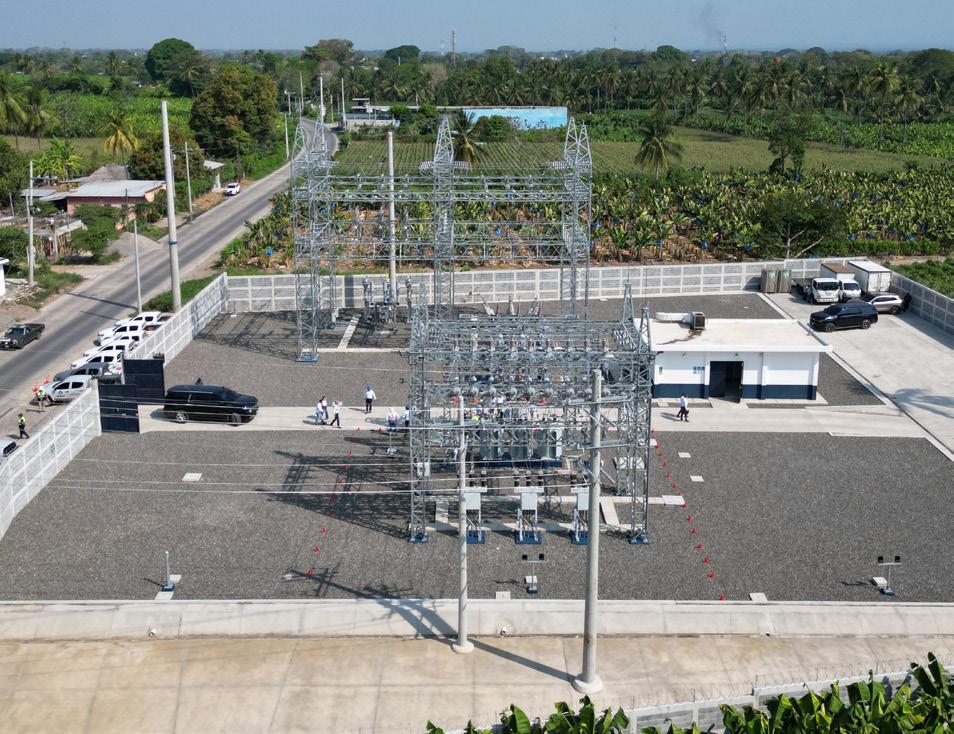
In 2024, a new system for managing power supply interruptions was implemented. This platform features a predictive engine that allows incidents to be linked to specific equipment, helping to optimize the response and resolution process.
WE DISTRIBUTE ELECTRICITY WITH QUALITY STANDARDS AND WITH THE GOAL OF MAKING GUATEMALA A GREAT COUNTRY”.
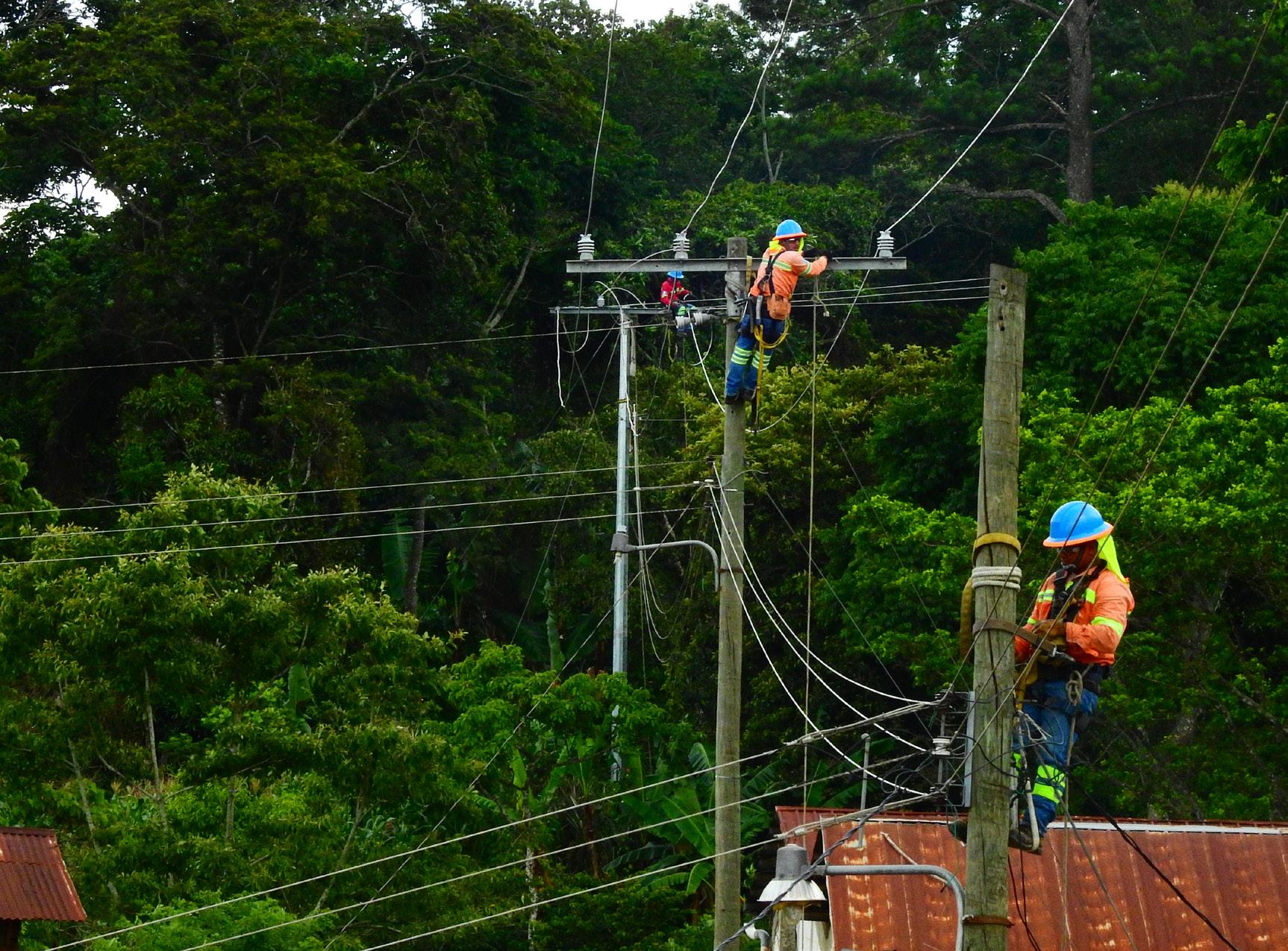
#GRI
GRI 102-1
LOCATION
https://www.energuate.com/
GRI 102-2 https://www.energuate.com/
GRI 102-3
GRI 102-4
https://oficinavirtual.energuate.com/contacto
https://www.energuate.com/Docs/Centros/oficinas-ymunicentros-ubicacion-y-horarios-de-atencion.pdf
GRI 102-5 -
GRI 102-6
GRI 102-7
GRI 102-8
GRI 102-9
https://www.energuate.com/tramites-y-servicios/ nuevos-servicios.html
https://www.energuate.com/c-digo-de-conducta-deproveedores-y-contratistas
https://www.energuate.com/codigo-de-conducta-deproveedores-y-contratistas.html
GRI 102-10 -
GRI 102-11
GRI 102-12
GRI 102-13 -
GRI 102-14 Page 3
GRI 102-15 Page 5
GRI 102-16 https://www.energuate.com/codigo-de-conducta-deproveedores-y-contratistas.html
GRI 102-17
GRI 102-18
DESCRIPTION
Name of the Organization
Activities, Brands, Products, and Services
Location of Headquarters
Location of Operations
Ownership and Legal Form
Markets and Services
Size of the Organization
Information on Employees and Other Workers
Supply Chain
Significant Changes in the Organization and its Supply Chain
Precautionary Principle or Approach
External Initiatives
Membership in Associations
Statement from the General Manager Responsible for Decision-Making (including sustainability in the company)
Main Impacts, Risks, and Opportunities
Convictions, Standards, and Code of Conduct
Mechanisms for Advice and Ethical Concerns
Governance Structure
GRI 102-19
GRI 102-20 -
GRI 102-21
GRI 102-22
GRI 102-23
GRI 102-24
GRI 102-25
Pages 5, 6 and 15
Page 8
Delegation of Authority
Executive-Level Responsibility for Economic, Environmental, and Social Topics
Consultation with Stakeholders on Economic, Environmental, and Social Topics
Composition of the Highest Governance Body and Its Committees
President of the Highest Governance Body
Nomination and Selection Process for the Highest Governance Body
Conflicts of Interest
GRI 102-26Role of the Highest Governance Body in Setting Purpose, Values, and Strategy
GRI 102-27 - Collective Knowledge of the Governance Body
GRI 102-28Evaluation of the Highest Governance Body’s Performance
GRI 102-29 Page 5
GRI 102-30 Pages 5 and 9
GRI 102-31 Page 5
GRI 102-32 Page 3
GRI 102-33
Identification and Management of Economic, Environmental, and Social Impacts
Effectiveness of Risk Management Processes
Evaluation of Economic, Environmental, and Social Issues
Role of the Highest Governance Body in Sustainability Reporting
Communication of Critical Problems
GRI 102-34 - Nature and Total Number of Critical Problems
GRI 102-35 - Remuneration Policies
GRI 102-36 - Process for Determining Remuneration
GRI 102-37 - Stakeholder Involvement in Remuneration
GRI 102-38 - Ratio of Annual Total Compensation
GRI 102-39
GRI 102-40
GRI 102-41
Percentage Increase in Annual Total Compensation Ratio
List of Stakeholder Groups
Collective Bargaining Agreements
GRI 102-42 - Identification and Selection of Stakeholders
GRI 102-43 Page 15 Approach to Stakeholder Engagement
GRI 102-44 - Key Topics and Concerns Raised
GRI 102-45
GRI 102-46 Page 5
GRI 102-47 Page 2
GRI 102-48
Entities Included in the Consolidated Financial Statements
Definition of Report Content and Topic Coverage
List of Material Topics Prioritized in the Report
Restatements of Information
GRI 102-49 - Changes in Reporting
GRI 102-50 January 2024 - December 2024 Reporting Period
GRI 102-51 January 2023 - December 2023
Date of Most Recent Report
GRI 102-52 Annual Reporting Cycle
GRI 102-53 https://www.energuate.com/ Contact Point for Questions Regarding the Report
GRI 102-54Statement of Reporting in Accordance with the GRI Standards
GRI 102-55 Page 25
GRI 102-56 Financial Statements - ISO 45001 Audits
GRI 103-1
GRI 103-2
GRI 103-3
GRI 201-1
GRI 201-2
GRI 201-3
GRI 201-4
GRI 202-1
GRI 202-2
GRI 203-1
GRI Content Index
External Verification
Explanation of the Material Topic and Its Coverage
Management Approach and Its Components
Evaluation of the Management Approach
Description of Economic Value Generated and Distributed (EVGD)
Financial Implications, Opportunities Arising from Climate Change, and Other Risks
Obligations of Defined Benefit Plans and Other Retirement Plans
Financial Assistance Received from Government
Ratio of Standard Entry-Level Wage by Gender Compared to Local Minimum Wage
Proportion of Senior Management Hired from the Local Community
Investments in Infrastructure and Supporting Services
GRI 203-2 - Significant Indirect Economic Impacts
GRI 204-1
Proportion of Spending on Local Suppliers
GRI 205-1 Page 6 Description of Operations Assessed for Risks Related to Corruption
GRI 205-2 Page 7 Communication and Training on Anti-Corruption Policies and Procedures
GRI 205-3 - Confirmed Incidents of Corruption and Actions Taken
GRI 206-1Legal Actions for Anti-Competitive Behavior, Anti-Trust, and Monopoly Practices
GRI 207-1 - Tax Approach
GRI 207-2
GRI 207-3
GRI 207-4
Tax Governance, Control, and Risk Management
Stakeholder Engagement and Management of TaxRelated Issues
Country-by-Country Reporting (Description of All Tax Jurisdictions; Consolidated and Audited Financial Statements or Financial Information Filed in Public Registers Where Entities Are Tax Residents)
GRI 301-1 - Materials Used By Weight or Volume
GRI 301-2
GRI 301-3
Recycled Inputs
Reused Products and Packaging Materials
GRI 302-1 Page 13 Energy Consumption Within the Organization
GRI 302-2 - Energy Consumption Outside the Organization
GRI 302-3 - Energy Intensity
GRI 302-4 Pge 13 Reduction of Energy Consumption
GRI 302-5Reduction of Energy Requirements of Products and Services
GRI 303-1 - Interaction with Water as a Shared Resource
GRI 303-2 - Management of Water Discharge-Related Impacts
GRI 303-3 - Water Withdrawal
GRI 303-4 - Water Discharge
GRI 303-5 Page 12 Water Consumption
GRI 304-1Description of Operations Centered on Ownership and Their Location Within or Adjacent to Protected Areas
GRI 304-2 - Significant Impacts of Activities Conducted
GRI 304-3 - Protected or Restored Habitats
GRI 304-4 - Species Affected in Operational Areas
GRI 305-1 Page 13
GRI 305-2 Page 13
Direct Greenhouse Gas Emissions (Scope 1)
Indirect Greenhouse Gas Emissions from Energy Generation (Scope 2)
GRI 305-3 - Other Indirect Greenhouse Gas Emissions (Scope 3)
GRI 305-4 Page 13 Greenhouse Gas Emission Intensity
GRI 305-5 Page 13 Greenhouse Gas Emissions Reductions
GRI 305-6 - Emissions of Ozone-Depleting Substances
GRI 305-7Nitrogen Oxide (NOx), Sulfur Oxide (Sox), and Other Significant Air Emissions
GRI 306-1 - Total Volume of Water Discharged by Destination and Quality
GRI 306-2 Page 13 Waste by Type and Disposal Method (Hazardous and NonHazardous)
GRI 306-3 - Total Volume of Spills of Hazardous Substances
GRI 306-4 - Transport of Hazardous Waste (Volume of Transport)
GRI 306-5 Page 13
Waste Destined for Disposal in Tons
GRI 307-1Non-Compliance with Environmental Laws and Regulations
GRI 308-1 - New Suppliers Screened Using Environmental Criteria
GRI 308-2Negative Environmental Impacts in the Supply Chain and Actions Taken
GRI 401-1 Page 20 New Employee Hires and Employee Turnover
GRI 401-2Benefits Provided to Full-Time Employees That Are Not Given to Part-Time or Temporary Employees
GRI 401-3 - Maternity Leave
GRI 402-1 - Minimum Notice Periods for Operational Changes
GRI 403-1 Page 21
Occupational Health and Safety Management System
GRI 403-2Hazard Identification, Risk Assessment, and Incident Investigation
GRI 403-3 - Occupational Health Services
GRI 403-4 Page 10
GRI 403-5 Page 10
GRI 403-6 Page 21
GRI 403-7 Page 10
GRI 403-8
GRI 403-9 Page 11
Worker Participation, Consultation, and Communication on Occupational Health and Safety
Worker Training on Occupational Health and Safety
Promotion of Worker Health
Prevention and Mitigation of Health and Safety Impacts Directly Linked to Business Relationships
Employees Covered by a Health System or Insurance from Work
Work-Related Injuries
GRI 403-10 - Work-Related Illnesses and Conditions
GRI 404-1 - Average Hours of Training Per Year Per Employee -
Dimension
Environment
Greenhouse Gas Emissions
Scope 1 Emissions
Air Quality
Percentage Included Under Emissions Reporting Regulations
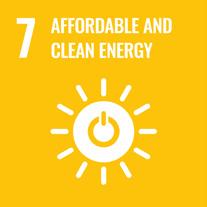
ENERGUATE reports 100% of its Scope 1 emissions, in compliance with the regulations of all the countries
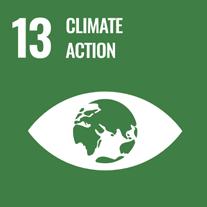
Discussion of Strategies for Emissions Reduction
Air emissions of the following pollutants (percentage of each emitted in or near densely populated areas): (1) NOx (excluding N2O) (2) SOx
Particulate Matter (PM10)
Lead (Pb)
Mercury (Hg)
Water withdrawal, water consumption, and percentage of operations in water-stressed areas
As a distribution company, ENERGUATE does not generate this type of air emissions
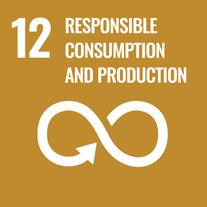
Water and Wastewater Management
Number of incidents of noncompliance related to water quantity and/or quality permits, standards, and regulations
Description of water management risks and discussion of strategies and practices to mitigate them
No incidents of noncompliance were reported related to water, water quality, and/ or associated permits, standards, or regulations


Environment Management of Hazardous Materials and Waste
Social Capital Access and Affordability
Amount of coal combustion residuals (CCR) generated and percentage recycled
Total number of coal combustion residual (CCR) impoundments, broken down by hazard potential classification and structural integrity assessment
Average retail electricity rate for (1) residential, (2) commercial and (3) industrial customers
Monthly electricity bill for residential customers for (1) 500 kWh and (2) 1,000 kWh of electricity delivered per month
As a distribution company, ENERGUATE does not generate this type of waste
As a distribution company, ENERGUATE does not generate this type of waste
Please visit the following link: https://oficinavirtual. energuate.com/ mifactura/tarifario
See the customer section on ENERGUATE’s distribution company website at the following link: https://oficinavirtual. energuate.com/ mifactura/tarifario

Number of residential customer electricity disconnections due to non-payment, percentage reconnected within 30 days
Discussion of the impact of external factors on electricity customer affordability, including the economic conditions within the service territory
Disconnecting a customer’s service due to non-payment is the final step in a lengthy process and is carried out in accordance with local regulations after all legally permitted options have been exhausted
See “Mi Factura” (“My Bill”) section on ENERGUATE’s website at the following link: https://oficinavirtual. energuate.com/mifactura
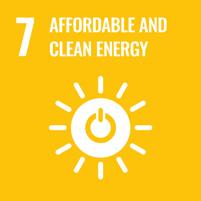

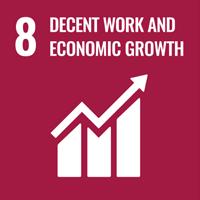
Business Model and Innovation
Business Model Resilience
We share efficient measures to help customers save electricity
Leadership and Governance Systemic Risk Management
The number of incidents resulting from noncompliance with physical and/ or cybersecurity standards or regulations
See “Manual del Cliente” (“Customer’s Manual”) section on ENERGUATE’s website at the following link: https://oficinavirtual. energuate.com/manual
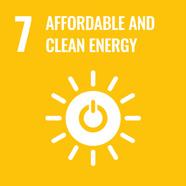
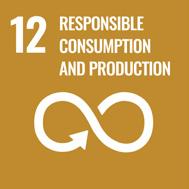
No incidents resulting from non-compliance with physical and/or cybersecurity standards or regulations
(1) System Average Interruption Duration Index (SAIDI), (2) System Average Interruption Frequency Index (SAIFI), and (3) Customer Average Interruption Duration Index (CAIDI), including major event days
The Technical Standards for Distribution Service (NTSD) establish the rights and obligations of electricity distributors and users, as well as benchmark indicators to meet the quality requirements under which energy services are provided in Guatemala. They also define the verification of permissible tolerances, control methods, compensation, penalties, and/or fines related to product quality, technical service quality, and commercial service quality


